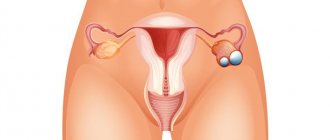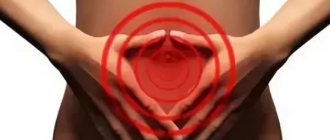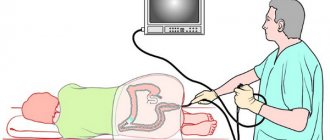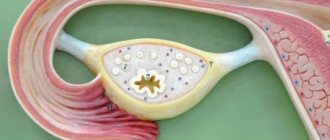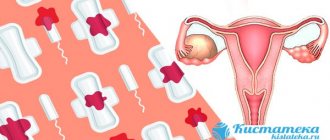Causes and associated symptoms
Typically, in women diagnosed with an ovarian cyst, if pain occurs, it is accompanied by other accompanying symptoms.
Among them:
- Menstrual irregularities, bleeding between periods.
- Pain in the lower abdomen (can radiate to the rectum, side, lower back, upper peritoneum, etc.).
- Tension of the muscles of the anterior abdominal wall.
- Bloating and heaviness in the abdomen, a feeling of fullness from the inside.
- Intestinal disorders.
- Difficulty urinating with constant urge (as with cystitis).
- Pain during sexual intercourse or physical activity.
Without accompanying symptoms, pain from an ovarian cyst can be confused with the manifestation of other diseases - endometriosis, pelvic inflammatory diseases, ectopic pregnancy, appendicitis, and cancer. Therefore, it is important to consider the clinical picture as a whole - only a qualified physician can fully restore it from the patient’s words, and you should contact her for advice.
Where does it hurt?
In a situation where pain occurs, it is usually difficult to indicate a specific location, because they have an aching and pulling nature, radiating in different directions and nearby organs. But the source of pain is localized on the side where the ovarian cyst is located and growing.
While the cyst increases in volume and does not manifest any symptoms, there is therefore no treatment for this disease and complications, even life-threatening, may occur.
With a cyst of the right ovary
The pain will appear on the right side, radiating to the right leg and thigh. Severe pain in the right lower abdomen at the beginning and after the menstrual cycle, after sex, physical activity.
With a cyst of the left ovary
Appears similarly in the left part of the lower abdomen, of a pulling nature. Acute pain is usually in the left side of the lower abdomen during the menstrual cycle, after sex, or physical activity.
Also, these sensations are complemented by other symptoms, which together can be used to determine an accurate diagnosis. There may be an increase in the size of the abdomen, a feeling of distension and fullness.
Localization of pain with an ovarian cyst
- Hypogastrium
- Groin area
- Small of the back
- Sacrum
- Lower limbs
- Rectum
Depending on the type of cyst, the pain may intensify before the next menstruation (with endometrioma) or vice versa - it may not be associated with the menstrual cycle.
The nature of the pain also depends on the type of cyst. Thus, aching pain with an ovarian cyst is provoked by irritation of the nerve endings of the peritoneum, spasms of the bladder and other hollow pelvic organs. Cystadenomas and malignant cysts cause the onset of pain much earlier, and attacks of pain are repeated more often. This is due to the fact that such cysts grow very quickly and can grow into the abdominal wall, bladder, and rectum. Mucinous cysts provoke severe, bursting pain from the inside, as they are usually very large in size.
Treatment
Treatment tactics are selected in accordance with the nature of the formation, the severity of symptoms, the risk of developing oncology, the age and general health of the patient, and the importance of preserving reproductive functions. Conservative treatment with watchful waiting is indicated for functional neoplasms with an uncomplicated course. In some cases, a special diet, acupuncture, and physical therapy are indicated. If there is no therapeutic effect and the formation continues to grow, surgical intervention is recommended.
Conservative
This method of treatment, depending on the patient’s condition and prognosis, includes a special diet, bed rest or physical therapy, homeopathic and herbal medicine. Medications of the following pharmacological groups are prescribed:
- Analgesics (Ibuprofen).
- Anti-inflammatory drugs (Acetaminophen).
- Hormonal drugs (Duphaston and other progesterone derivatives, monophasic or biphasic oral contraceptives to normalize the menstrual cycle and reduce the size of tumors).
- Vitamin complexes.
Surgical intervention
If there is no effect from therapeutic treatment or aggressive growth and other rapid changes in the tumor, if a rupture or twisting of the leg is suspected, the following types of surgical interventions are performed:
- Laparoscopic removal is a procedure in which removal is performed with special endosurgical instruments through trocar punctures. The invasiveness of the method is minimal with maximum preservation of functional ovarian tissue.
- Wedge resection is the excision of a neoplasm with surrounding tissues.
- Cystectomy – the cyst capsule is removed from its bed and homeostasis is carried out. The gland tissues are preserved, and its reproductive functions are completely restored.
- Oophorectomy - removal of the ovary, sometimes in severe cases the appendages are completely removed, this intervention is called adnexectomy.
Pain when an ovarian cyst ruptures
Separately, it is worth considering pain when an ovarian cyst ruptures.
The rupture of a follicular cyst can be accompanied by tolerable pain (if it occurs in the middle of ovulation), but the pain from a rupture of a dermoid cyst is almost impossible to withstand, so women often fall into a state of shock.
Whatever the type of cyst, usually pain when an ovarian cyst ruptures begins suddenly in the lower abdomen, and then quickly moves to the upper sections, so that the entire abdomen begins to ache. Moreover, the appearance of such pain can be provoked by harsh sexual intercourse, heavy physical exercise, a pelvic injury, a blow to the lower abdomen, or even simply palpating the abdomen.
When trying to move, the pain intensifies and is accompanied by a nagging discomfort in the back, lower back or pelvic area, and a feeling of heaviness. By the way, these sensations may appear shortly before an attack of pain.
Abdominal pain when an ovarian cyst ruptures can be so severe and prolonged that tachycardia occurs, blood pressure drops, shock and loss of consciousness occur.
Nature of pain
Often, ovarian cysts form and grow at first without any symptomatic manifestations that would force a woman to immediately consult a doctor.
However, in some cases, symptoms can still be expressed. The pain can be localized and moderate, or intense, spreading throughout the entire abdomen.
Most often, minor pain with a cystic neoplasm appears after sexual intercourse, excessive physical activity, or due to damage to the groin area. Regular pain in the lower abdomen occurs with rapid enlargement of the cavity, large formation, or compression of neighboring organs by a defect. Severe painful discomfort, combined with other symptoms, indicates the development of complications.
In addition, the nature of the pain depends on the type of disease. With follicular formation, irregular painful sensations affect the right or left side in the lower abdominal cavity. A mucinous cyst leads to a pronounced syndrome and a feeling of pressure.
With polycystic or dermoid formation, the pain is long-lasting, severe, radiating to the leg, lumbar region, and pelvic area. An endometrioid cyst, in addition to constant and severe discomfort, causes cramps in the lower extremities.
The severity and nature of pain with an ovarian cyst depends on the structure, size and growth rate of the formation. The following types of pain syndrome are characteristic of different types of disease:
- Follicular – irregular, mild pain in the right or left side of the lower abdomen.
- Mucinous - a feeling of pressure in the lower abdomen. The pain syndrome is severe, sensations radiate to the legs. As the size of the tumor increases, the pain becomes stronger due to the pressure of the cyst on the surrounding internal organs.
- Polycystic. The pain syndrome is moderate, nagging pain in the lower abdomen can radiate to the lower back and pelvic region.
- Dermoid. The pain is severe and prolonged. The analgesic effect when using conservative methods or taking analgesics is weak.
- Endometrioid. Prolonged severe pain in the lower abdomen and back may be accompanied by cramps of the limbs.
- Corpus luteum cyst. In the absence of complications, abdominal pain is mild or completely absent.
When the legs are twisted
Acute severe pain with an ovarian cyst occurs when the course of the disease is complicated, for example, when the pedicle of the formation is torsed. This situation requires immediate hospitalization of the patient and removal of the formation, because due to impaired local circulation there is a risk of developing a necrotic process. The clinical signs of torsion are the following:
- heat;
- dizziness, vomiting;
- copious discharge of mucus from the vagina;
- pale skin on the face, arms and abdomen;
- lowering blood pressure to critical levels;
- loss of consciousness is possible.
When breaking
The symptoms of ovarian cyst rupture are similar to the symptoms of pedicle torsion; the process provokes vomiting or nausea, increased body temperature or intoxication, and acute sharp pain in the abdomen and lower back. The entry of secretions from the ruptured cavity of the neoplasm into the peritoneum can provoke peritonitis, so the victim needs urgent hospitalization and emergency surgery.
Ovarian cyst pain: treatment
The cause of pain is diagnosed using:
- Ultrasound
- Punctures
- Diagnostic laparoscopy
If the patient is diagnosed with a cyst rupture or torsion, as well as a large cyst, a decision is made on urgent surgery to remove the tumor. Doctors often have to make this decision urgently - after emergency hospitalization of the patient.
To remove a painful ovarian cyst, the minimally invasive method of laparoscopy is ideal - an operation that guarantees a minimum recovery period for the body.
After the operation, the attending physician prescribes hormonal therapy to the patient.
Help with pain and treatment of pathologies
A wait-and-see approach in the event of pain is justified in the following situations:
- Follicular or luteal formation of small size, existing for no more than 3 months;
- Newly diagnosed ovarian cyst during pregnancy;
- No complications: pedicle torsion, ovarian rupture;
- Benign nature of the formation without signs of malignancy.
Conservative therapy for painful ovarian cysts includes:
- Hormonal drugs: combined oral contraceptives. Prescribed for functional cysts in young women. Do not use during menopause, with caution in smoking patients. Prescribed according to a contraceptive scheme (21+7 or 24+4) for a course of 3 months. COCs do not relieve pain, but help reduce the size of the cyst. The formation resolves and the discomfort disappears;
- Nonsteroidal anti-inflammatory drugs (NSAIDs) based on paracetamol, ibuprofen, ketorolac, etc. Help relieve pain and last from 4 to 12 hours. Painkillers are prescribed only in the acute phase and are not used for more than 5 days in a row. If symptoms increase and the woman’s condition worsens, surgical treatment is indicated;
- Antispasmodics are used as an adjuvant (drotaverine, papaverine). Prescribed in a course of 5-10 days, used in rectal suppositories or tablets. Help relieve spasm and pain.
In case of functional formations, medications can help get rid of the cyst; in other cases, medications help relieve pain symptoms, but do not eliminate the pathology.
Painkillers are purely symptomatic therapy, helping only to relieve pain, but not solving the problem. NSAIDs and antispasmodics do not affect the course of the disease. They do not promote cyst resorption and do not prevent the development of complications. Such drugs alleviate a woman’s condition, but do not replace basic treatment and do not allow surgery to be avoided if indicated.
Non-drug treatment for pain syndrome:
- Warm (not hot!) baths with medicinal herbs. Mint, valerian, St. John's wort and some other plants have a slight analgesic effect, which allows them to be used in complex therapy;
- Physiotherapy: electrophoresis, laser therapy, magnetic therapy (without thermal effects).
The opinion of doctors regarding the pain syndrome with ovarian cysts is clear: if the discomfort increases, it is necessary to plan an operation. According to reviews, the effect of conservative therapy is observed only during the first 2-3 months. If the tumor has not resolved during this time, further medication does not make sense.
If conservative treatment is ineffective or the condition worsens, surgical intervention is indicated.
Observing an ovarian cyst does not imply that a woman will take painkillers for the entire three months. If medications do not help and the pain cannot be tolerated, then surgical treatment is performed.
For ovarian cysts, the following are prohibited:
- Hot baths, including foot baths;
- Solarium, sauna, steam bath;
- Physiotherapy with heating;
- Hirudotherapy.
All procedures that involve increased blood flow in the pelvic organs can lead to the growth of ovarian formations and increased pain.
The lack of effect of conservative therapy within 3 months is a reason for surgery. After the cyst is removed, the discomfort subsides. If the formation is excised, the pain remains, you should consult a doctor again - perhaps a concomitant pathology was missed or postoperative complications developed. The same tactics are indicated if the functional cyst goes away on its own, and discomfort in the lower abdomen persists for a long time.
If you experience pain due to the formation of an ovary, you should not delay your visit to the doctor. Such symptoms indicate that education is growing, and without medical help it will not be possible to cope with the problem. It is important to remember that only functional cysts tend to resolve on their own. Dermoid and other formations do not disappear on their own. If the doctor insists on surgery, do not delay treatment. Refusal of adequate therapy threatens uncontrolled growth of the cyst and the development of serious complications that are life-threatening to the woman.
Often an ovarian cyst does not make itself felt and is asymptomatic. However, at one moment a woman may feel severe pain in the lower abdomen, and her overall health worsens. If such symptoms appear, you should not delay visiting a gynecologist.
Is it possible to relieve cyst pain on your own?
Pain from an ovarian cyst can be relieved with traditional pain medications - non-steroidal anti-inflammatory drugs (ibuprofen, acetaminophen). This is acceptable if the patient receives primary treatment at the same time.
However, before taking pills, it is better to consult with your doctor, since characteristic pain is the most important symptom, and by muffling it, you may not notice the deterioration of the condition in time.
Some medical portals also recommend using heat (taking a hot bath, applying a heating pad to a sore spot) to alleviate the condition at home. This advice is dictated by the effect of warm temperature on the relaxation of muscles constrained by painful spasms. However, this method is quite risky and is not recommended for use if there is even the slightest suspicion of rupture or torsion of the cyst, since high temperature will intensify the inflammatory process and accelerate the appearance of internal suppuration.
In case of cyst pain, strict limitation of physical and sexual activity is mandatory. Since one sudden movement is often enough for the inflamed cyst to burst.
Medicines
If severe pain occurs due to a cystic formation of the right or left ovary, it is permissible to use medications.
You can use your own strength to help relieve pain. At the same time, quite ordinary and well-known painkillers come to the rescue. However, they should be used only after consultation with the attending physician and in parallel with the main treatment.
This includes drugs that relieve pain; painkillers include Ibuprofen or Paracetamol. Antispasmodic drugs, such as Spazmolgon, No-shpa, can help reduce and drown out the sensations of an ovarian cyst.
However, it is worth remembering the importance of using tablets in moderation. After all, based on the strength and nature of the pain, a gynecologist can determine the patient’s condition, the presence of complications and indicate to the woman the need to see a doctor for help. By dulling the pain or removing it altogether, there will be no such possibility of diagnosis.
Read more Papillomas have started to grow, what to do?
